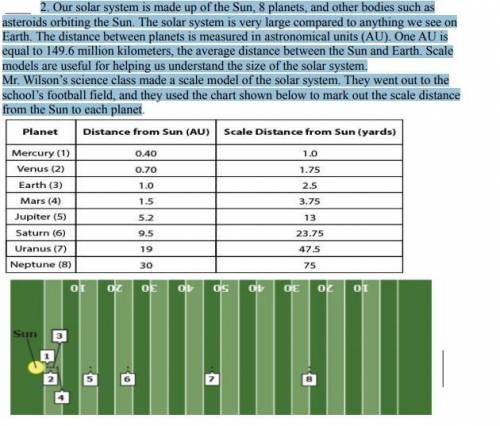
Physics, 08.06.2021 16:20 XxalyxX3487
Our solar system is made up of the Sun, 8 planets, and other bodies such as
asteroids orbiting the Sun. The solar system is very large compared to anything we see on
Earth. The distance between planets is measured in astronomical units (AU). One AU is
equal to 149.6 million kilometers, the average distance between the Sun and Earth. Scale
models are useful for helping us understand the size of the solar system.
Mr. Wilson’s science class made a scale model of the solar system. They went out to the
school’s football field, and they used the chart shown below to mark out the scale distance
from the Sun to each planet
The average orbital radius for a planet is its distance from the Sun. Which statement BEST
describes the relationship between the planets and their average orbital radii?
A. The planets are evenly spaced in the solar system.
B. Closer to the Sun, the planets are regularly spaced apart.
C. The planets closest to each other are the ones farthest from the sun.
D. Farther from the Sun, the planets are spaced farther apart from each other.


Answers: 1


Another question on Physics

Physics, 22.06.2019 07:20
Use the information presented in the graph to answer the questions. which segments show acceleration? which segment indicates that the object is slowing down? what is the velocity of segment b? what is the acceleration of segment b?
Answers: 3

Physics, 22.06.2019 20:30
You are doing a science experiment with a fahrenheit thermometer. your data must be in degrees celsius. if you measure a temperature of 125°f, what is this temperature in degrees celsius
Answers: 1

Physics, 22.06.2019 23:00
Acommon technique in analysis of scientific data is normalization. the purpose of normalizing data is to eliminate irrelevant constants that can obscure the salient features of the data. the goal of this experiment is to test the hypothesis that the flux of light decreases as the square of the distance from the source. in this case, the absolute value of the voltage measured by the photometer is irrelevant; only the relative value conveys useful information. suppose that in part 2.2.2 of the experiment, students obtain a signal value of 162 mv at a distance of 4 cm and a value of 86 mv at a distance of 5.7 cm. normalize the students' data to the value obtained at 4 cm. (divide the signal value by 162.) then calculate the theoretically expected (normalized) value at 5.7 cm.
Answers: 2

Physics, 23.06.2019 02:20
What are known as the properties of substances that describe a substance et does not change that substances?
Answers: 1
You know the right answer?
Our solar system is made up of the Sun, 8 planets, and other bodies such as
asteroids orbiting the...
Questions

Mathematics, 27.10.2020 20:50

Social Studies, 27.10.2020 20:50

Biology, 27.10.2020 20:50

Mathematics, 27.10.2020 20:50

Mathematics, 27.10.2020 20:50

Mathematics, 27.10.2020 20:50



Mathematics, 27.10.2020 20:50




Mathematics, 27.10.2020 20:50

History, 27.10.2020 20:50

Chemistry, 27.10.2020 20:50

Mathematics, 27.10.2020 20:50

Mathematics, 27.10.2020 20:50

Mathematics, 27.10.2020 20:50




